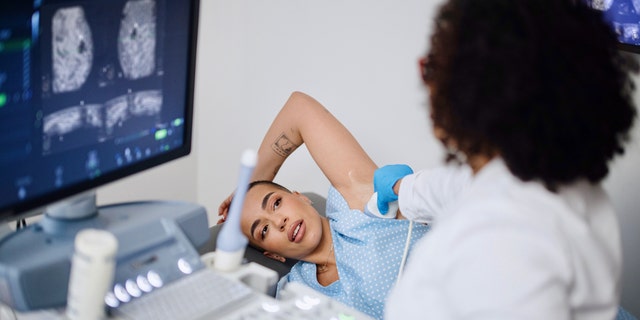Most women diagnosed with early breast cancer will survive beyond 5 years, study finds
Death rates from breast cancer have been on a steady decline in recent decades, dropping 43% between 1989 and 2020.
The average risk of dying from breast cancer in the five years after an early diagnosis has fallen from 14% to 5% since the 1990s, according to a recent study from the University of Oxford in Oxford, England, that was published in the British Medical Journal.
For those diagnosed between the years 2010 and 2015, more than six in 10 women had a 3% or less risk of dying within five years.
CARBOPLATIN, CISPLATIN DRUG SHORTAGES IMPACTING TREATMENT OF US CANCER PATIENTS: ‘UNACCEPTABLE SITUATION’
Early-stage breast cancer is defined as cancer that hasn’t spread beyond the breast or the axillary lymph nodes, according to the National Cancer Institute.
To uncover the details about the long-term risks of dying from breast cancer after an early diagnosis, researchers analyzed data from the National Cancer Registration and Analysis Service, a U.K. database that includes information on over 300,000 cases of cancer.
“We knew that prognosis after a diagnosis of early breast cancer is better now than it was in the past, but we didn’t know how much better,” said lead study author Carolyn Taylor, a consultant clinical oncologist and professor of oncology at the University of Oxford.
“In our study, we were able to show that the five-year risk of dying from breast cancer had reduced during the past 20 years for nearly every group of women we studied,” she told Fox News Digital.
TWO NEW CANCER PILLS SHOW ‘UNPRECEDENTED’ RESULTS IN BOOSTING SURVIVAL RATES AND PREVENTING RECURRENCE
The researchers analyzed data from over 512,000 women in England who had been diagnosed with early breast cancer between 1993 and 2015 and who were initially treated with surgery, said a press release announcing the findings.
The highest risk of death was seen in the five years following diagnosis, after which it started to decline.
The five-year mortality risk was 14.4% for women diagnosed between 1993 and 1999, and 4.9% for the group diagnosed between 2010 and 2015.

The risk varied according to the method of cancer detection, patient age, type of breast cancer, size and type of tumor, and whether the cancer had spread to the lymph nodes.
“Our study is good news for the great majority of women diagnosed with early breast cancer today because their prognosis has improved so much,” the researchers said in the press release.
“Most of them can expect to become long-term cancer survivors.”
“We knew that prognosis after a diagnosis is better now than it was in the past, but we didn’t know how much better.”
Early detection, as well as screening mammography and improvements in medical treatment, have all led to improvements in overall survival, noted Dr. Yvonne Estrin, assistant professor of radiology at the University of Miami, who was not involved in the study.
“The idea is to catch the cancer early, which improves mortality, but also morbidity,” she told Fox News Digital. “That’s why, in the United States, there was a recent change in guidelines, and now screening mammography for average-risk women begins at age 40 (previously 50). This will save many lives.”
The decline in deaths has not been seen in very rare, aggressive and rapidly growing breast cancers, noted Estrin.
“These tend to happen in younger women, those with genetic mutations and Black women,” she told Fox News Digital.
Study had limitations, say researchers
As this study was observational, the researchers stated in the press release that the findings can’t pinpoint what exactly caused the decline in mortality.
The study only included a subset of cancer patients — those who were initially treated with surgery and whose cancer had not spread.
“We are diagnosing a whole lot more breast cancers as we increase screenings.”
Women who had other types of treatments to reduce the size of cancer tumors, those with multiple types of cancer and women whose cancer had already spread were excluded.
Additionally, there was no data available about cancer recurrence.
Mortality decline could be due to increased screenings, expert says
Dr. Jennifer Simmons, functional medicine physician and integrative oncologist at Real Health MD in King of Prussia, Pennsylvania, found the results of the study to be generally encouraging. Simmons was not involved in the study.

“Based on this study, we can reliably give people survival statistics according to predictive measures that we weren’t able to do before in such a granular way,” she told Fox News Digital.
She did flag some caveats, however.
NEW BREAST CANCER SCREENING GUIDELINES CALL FOR WOMEN TO START MAMMOGRAMS AT AGE 40
Looking at the number of women diagnosed during each five-year time frame, Simmons pointed out the sharp increase.
Between 2000 and 2015, there was a 240% spike in diagnoses.
“We are diagnosing a whole lot more breast cancers as we increase screenings,” she told Fox News Digital.
There was also a big increase in the detection of “node-negative cancers” — cases in which the disease had not spread to the lymph nodes, Simmons said.
“We’re talking about a doubling of the number of node-negative cancers diagnosed,” she said.
Meanwhile, the node-positive cancers — “the more aggressive cancers, the disease that really needs treatment” — remained relatively stable, Simmons noted.
CLICK HERE TO SIGN UP FOR OUR HEALTH NEWSLETTER
“I worry that these detected cancers are not necessarily clinically relevant, and we are kind of falsely elevating our survival rates because we’re saying that people are surviving from breast cancer who would have survived anyway,” she told Fox News Digital.
“I think the reason these numbers look so good is because we’re picking up and treating cancers that didn’t need to be treated,” Simmons went on. “Our screening has almost gotten too sensitive.”
An estimated 43,700 U.S. women are expected to die from breast cancer in 2023, according to statistics from the National Breast Cancer Foundation.
Read the full article Here


